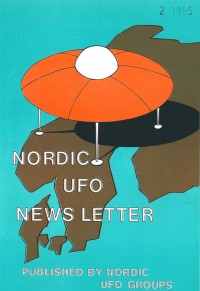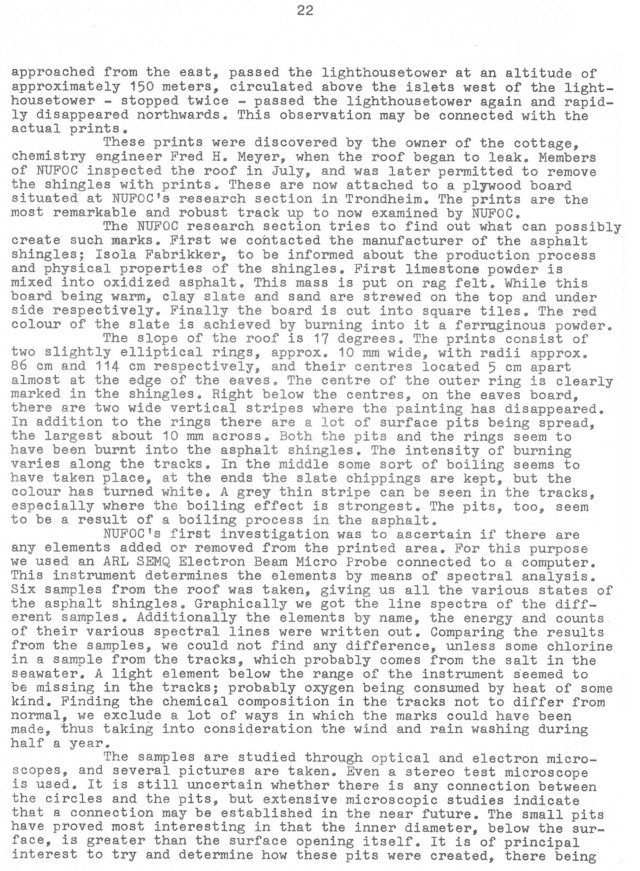Nordic UFO Newsletter1981, issue 1, page 22. |

|

|
approached from the east, passed the lighthouse tower at an altitude of approximately 150 meters, circulated above the islets west of the lighthouse tower - stopped twice passed the lighthouse tower again and rapidly disappeared northwards. This observation may be connected with the actual prints.
These prints were discovered by the owner of the cottage, chemistry engineer Fred H. Meyer, when the roof began to leak. Members of NUFOC inspected the roof in July, and was later permitted to remove the shingles with prints. These are now attached to a plywood board situated at NUFOC's research section in Trondheim. The prints are the most remarkable and robust track up to now examined by NUFOC.
The NUFOC research section tries to find out what can possibly create such marks. First we contacted the manufacturer of the asphalt shingles; Isola Fabrikker, to be informed about the production process and physical properties of the shingles. First limestone powder is mixed into oxidized asphalt. This mass is put on rag felt. While this board being warm, clay slate and sand are strewed on the top and under side respectively. Finally the board is cut into square tiles. The red color of the slate is achieved by burning into it a ferruginous powder.
The slope of the roof is 17 degrees. The prints consist of two slightly elliptical rings, approx. 10 mm wide, with radii approx. 86 cm and 114 cm respectively, and their centers located 5 cm apart almost at the edge of the eaves. The centre of the outer ring is clearly marked in the shingles. Right below the centers, on the eaves board, there are two wide vertical stripes where the painting has disappeared. In addition to the rings there are a lot of surface pits being spread, the largest about 10 mm across. Both the pits and the rings seem to have been burnt into the asphalt shingles. The intensity of burning varies along the tracks. In the middle some sort of boiling seems to have taken place, at the ends the slate chippings are kept, but the color has turned white. A grey thin stripe can be seen in the tracks, especially where the boiling effect is strongest. The pits, too, seem to be a result of a boiling process in the asphalt.
NUFOC's first investigation was to ascertain if there are any elements added or removed from the printed area. For this purpose we used an ARL SEMQ Electron Beam Micro Probe connected to a computer. This instrument determines the elements by means of spectral analysis. Six samples from the roof was taken, giving us all the various states of the asphalt shingles. Graphically we got the line spectra of the different samples. Additionally the elements by name, the energy and counts of their various spectral lines were written out. Comparing the results from the samples, we could not find any difference, unless some chlorine in a sample from the tracks, which probably comes from the salt in the seawater. A light element below the range of the instrument seemed to be missing in the tracks; probably oxygen being consumed by heat of some kind. Finding the chemical composition in the tracks not to differ from normal, we exclude a lot of ways in which the marks could have been made, thus taking into consideration the wind and rain washing during half a year.
The samples are studied through optical and electron microscopes, and several pictures are taken. Even a stereo test microscope is used. It is still uncertain whether there is any connection between the circles and the pits, but extensive microscopic studies indicate that a connection may be established in the near future. The small pits have proved most interesting in that the inner diameter, below the surface, is greater than the surface opening itself. It is of principal interest to try and determine how these pits were created, there being